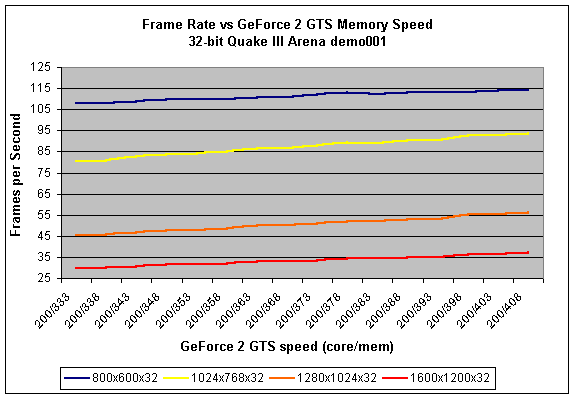Results of GeForce 2 GTS Limitations - The Memory


This time we see the that trend is rather different. As opposed to the results encountered when overclocking the core, overclocking the memory bus resulted in a seemingly linear increase in speeds across the board. The performance line is no longer horizontal, showing that card performance increases to a noticeable extent when just the memory clock is pushed up. This time, as opposed to before, we are actually increasing the effective fill rate of the card while leaving the theoretical fill rate unchanged. With this information, we can clearly see that the effective fill rate of the GeForce 2 GTS when at default clock is no where near the theoretical fill rate. By increasing the memory clock speed, we come closer and closer to eliminating this bottleneck and approaching the theoretical fill rate.
This shows the demand for higher speed RAM, as the 166 MHz DDR SGRAM chips that are shipping with 32 MB GeForce 2 GTS cards are quite frankly not up to par with the rest of the card. There is no question that raising the memory speed increased performance to a greater extent than raises in the core speed. When at default clock, the DDR RAM chips found on the GeForce 2 GTS possess 5.3 GB/s peak bandwidth. This number is found by taking the memory clock speed, 166 MHz, and multiplying it by 2 since the RAM is being written to twice per clock. Next, this product of 333 is multiplied by the memory bus width of 128 bits. This number must finally be converted from bits to bytes by using the fact that there are 8 bits in a byte, thus we divide the product found in the last step by 8 to get 5.3 GB/s peak bandwidth. As the core overclocking graph shows, the bottleneck formed by this "minimal" 5.3 GB/s bandwidth is enough to prevent the GeForce 2 GTS from achieving its full speed.
By raising the memory speed of the card, we were able to more closely simulate the theoretical fill rate of the GeForce 2 GTS GPU. At our maximum overclocked memory speed of 203 MHz DDR (406 MHz effective), the peak bandwidth of the card lied at an impressive 6.5 GB/s. Even at this bandwidth level our graphs did not begin to go horizontal, suggesting that the default clock the GeForce 2 GTS actually requires more bandwidth than this for theoretical fill rate to be realized.
Although memory bandwidth may seem like a plague on theoretical fill rate, there are actually worse evils in the world of rendering. We have yet to consider what happens when the data attempting to enter the card's memory can not be stored because of lack of space. Since the computer can not throw this information away or display only half of a scene, additional memory needs to be called upon in a process known as AGP texture swapping.










0 Comments
View All Comments